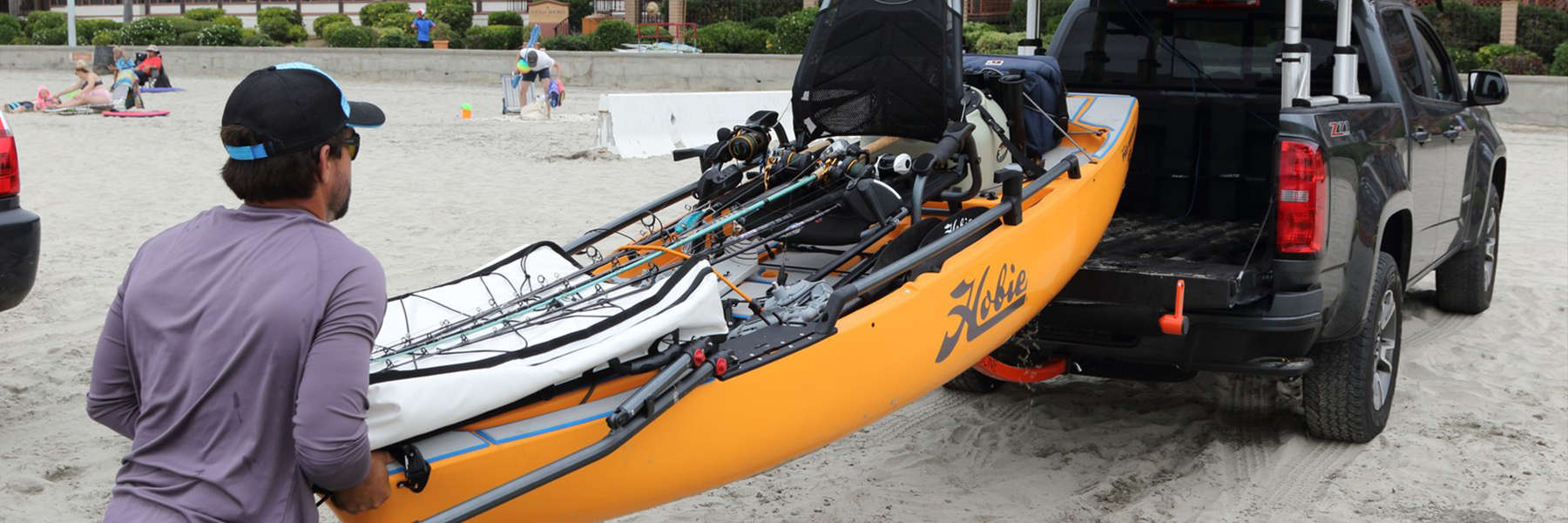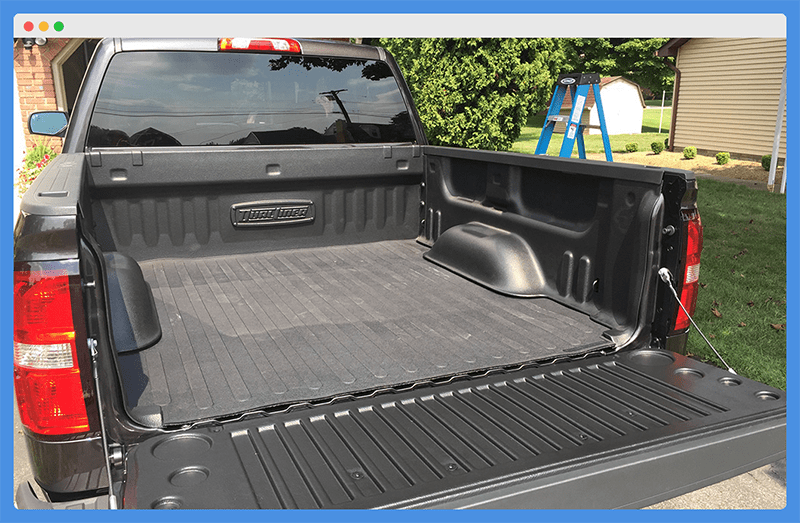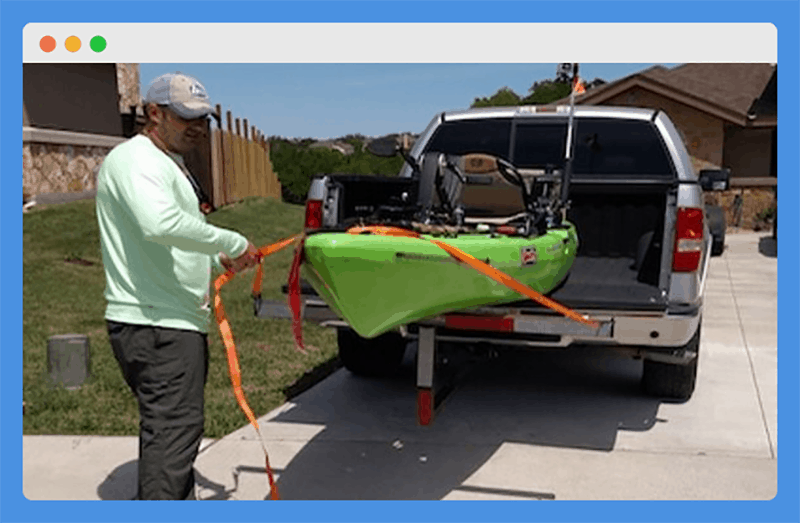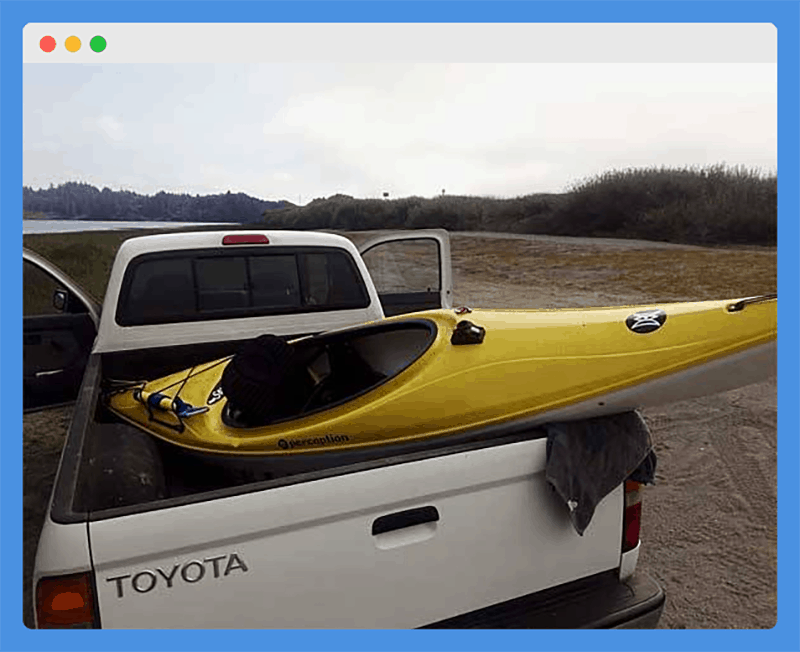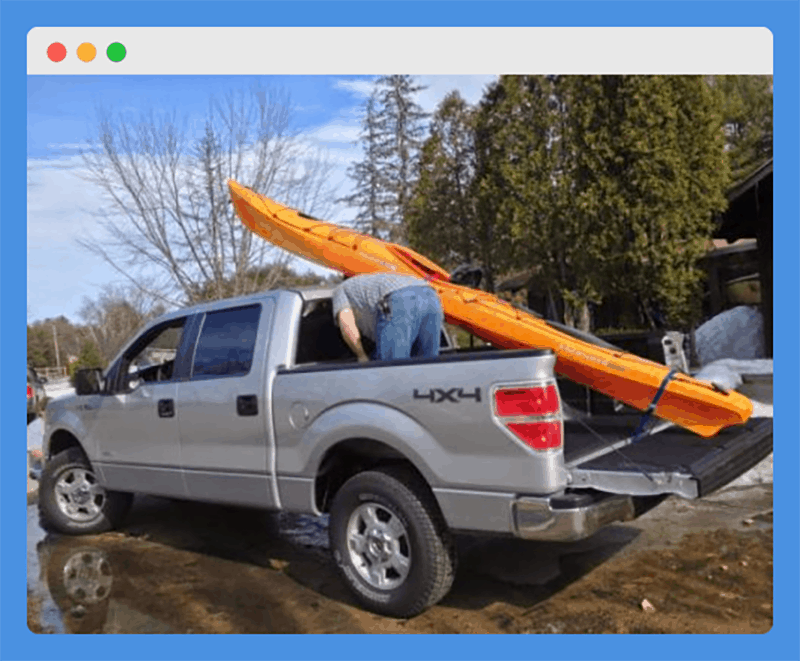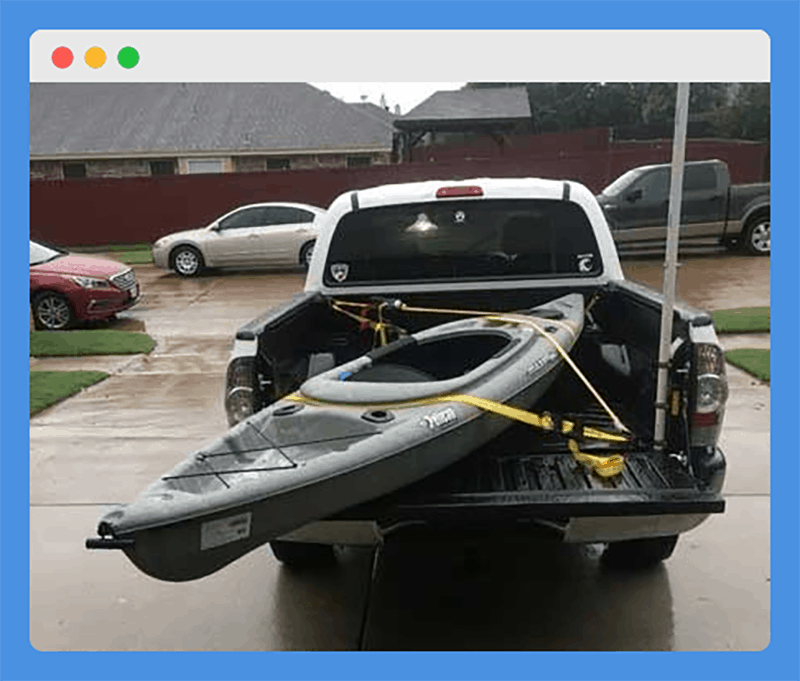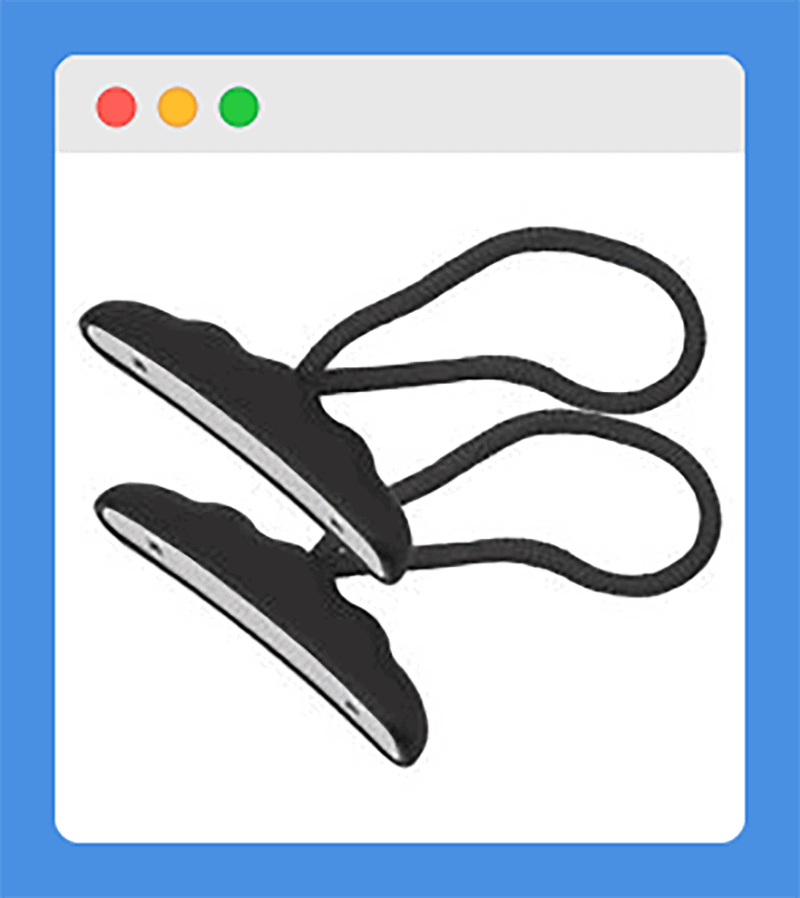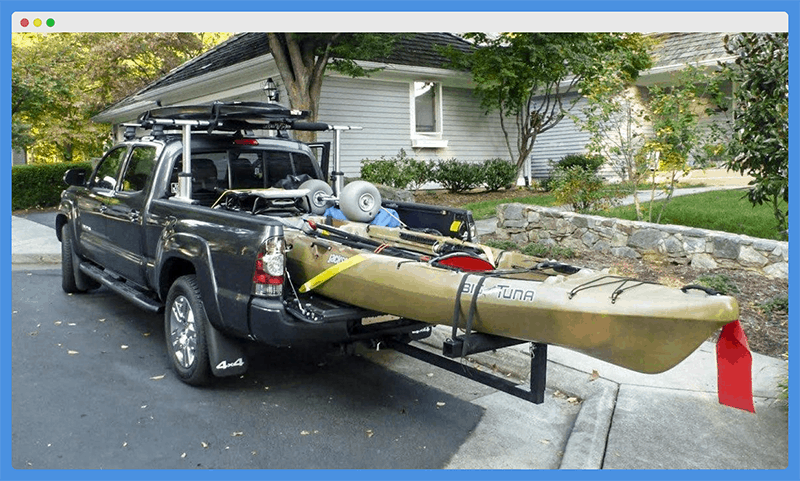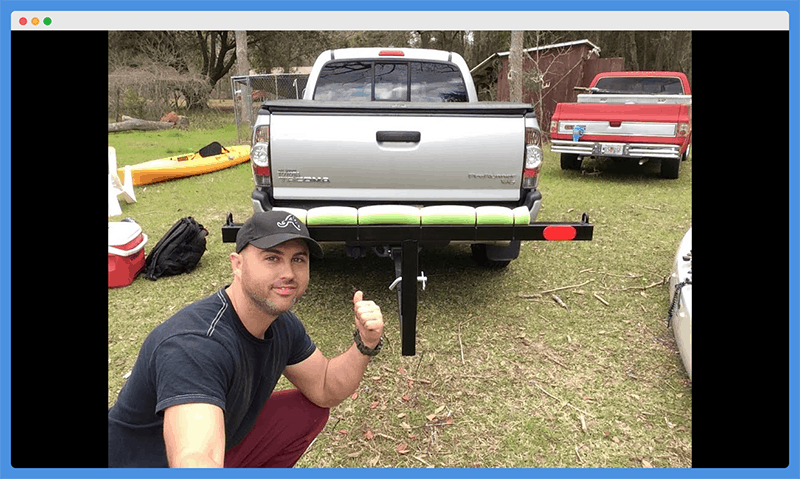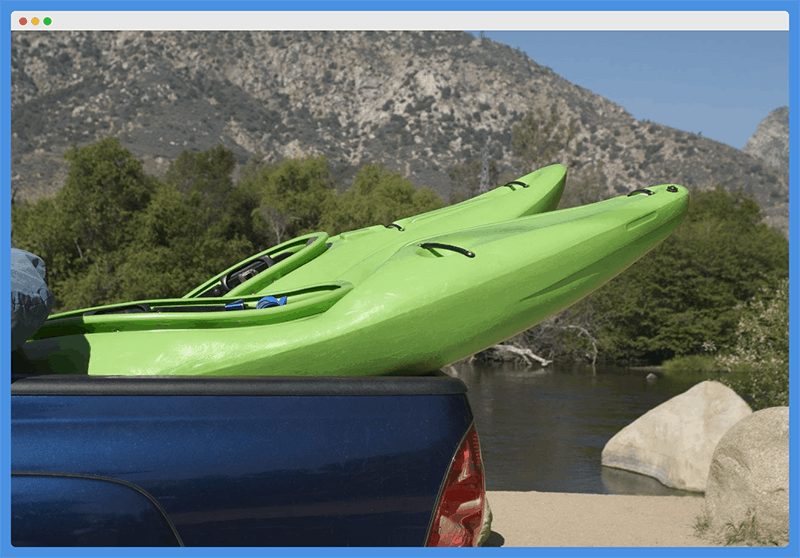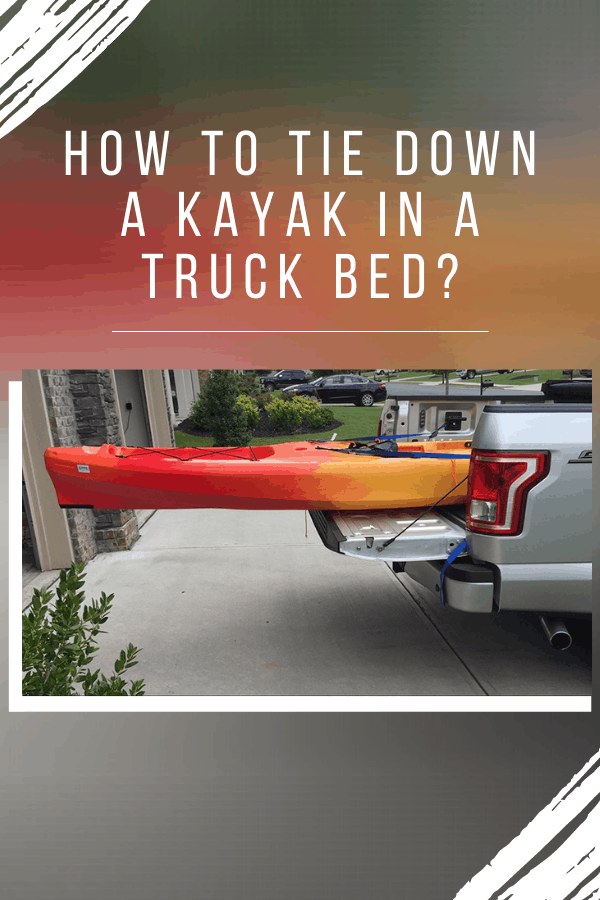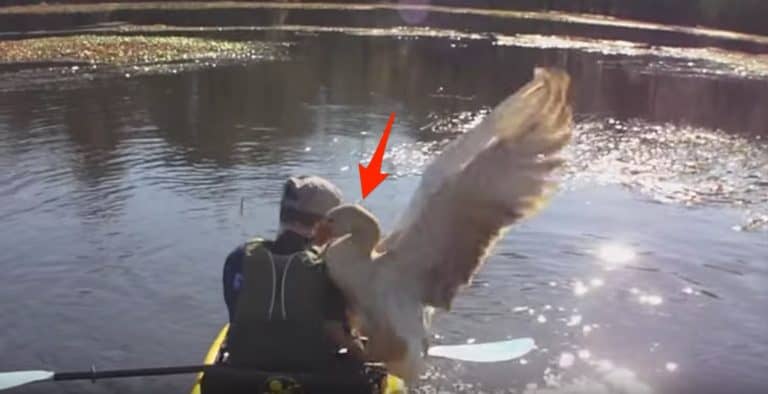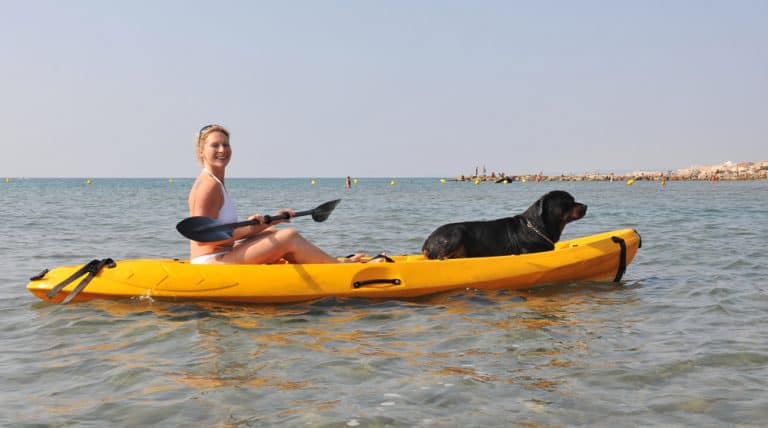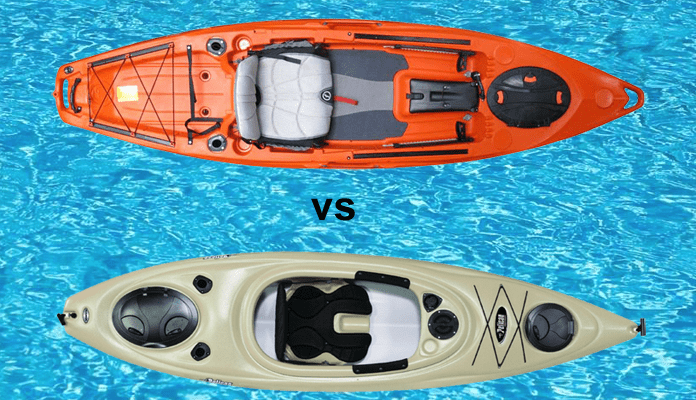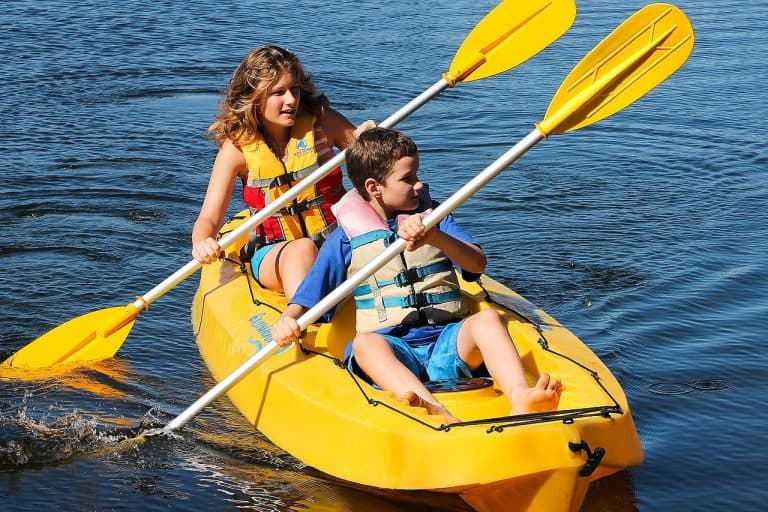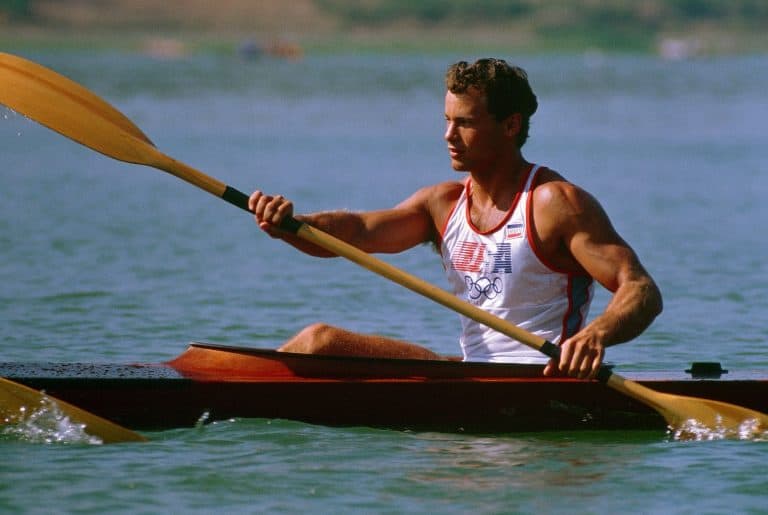If you already have a truck when you buy a new family kayak, you have the advantage of not necessarily having to choose one of the best two kayak roof racks to transport your watersports equipment.
Kayaks can easily be tied into the beds of most trucks, but you’ll need to do so safely to avoid damage to your kayaks and/or your truck.
Failure to secure your kayaks in a truck bed safely can also put other drivers on the road and lead to larger problems that you ever want to deal with.
So, the easiest thing to do is to learn how to tie down a kayak in a truck bed properly. Fortunately for you, we’re going to outline several useful methods for doing so today.
Let’s get right into it!
How To Tie Down A Kayak In A Truck Bed?
The right method for tying down your kayak will depend on several factors, including the size of your kayaks and the length of your truck bed. But there are several steps you can take to make sure you secure a kayak in your truck bed properly.
Prepare Your Truck Bed
The first thing you need to do when you’re ready to tie down a kayak in a truck bed is to prep the bed so that it’s as easy as possible to load your kayak in. Whether you’re loading one or two kayaks, it’s best to completely empty your truck bed to prepare it.
This will eliminate any items or kayak accessories that could get into your way as you’re loading your kayak (or kayaks). And it will also reduce the likelihood of strapping your kayak on top of something that could be damaged as you’re driving.
If you don’t already have a bed liner in your truck, we’d recommend installing one before tying down kayaks in there. A quality truck bed liner will protect both the bed of your truck and the integrity of your kayaks from potential damage.
In addition, you might consider placing a small foam pad across the front of your truck bed. This will give you something soft and padded to place the bow of your kayak on instead of placing it directly on the harder surface of your bed liner.
Place Kayak Straps
While the image above might be a bit misleading, we actually recommend setting your kayak cam straps in place before you load your kayak into your truck bed.
This will eliminate having to awkwardly reach around or underneath your kayak to set your straps in place before you can secure them.
Most truck beds have some sort of hooks or loops on the floor or walls of the bed that will serve you well as tie-down points for your kayak. The exact tie-down points you use will depend on the size of your kayak and the length of the cam straps you’re using.
Just remember that your goal is to tie your kayak(s) down to your truck bed. So, generally speaking, we recommend using tie-down points on the bottom of the truck bed whenever possible, rather than relying on higher tie-down points on the walls of your truck bed.
This will increase your odds of securing your kayak down properly and it will help you avoid simply strapping across your truck bed, which can still leave the door open for your kayak to slide right out of your truck bed if you’re climbing a significant hill or you accelerate quickly.
Load Your Kayak
Now that your straps are in place it’s time to load your kayak into your truck bed, and there are two basic methods for doing so.
For both of them, however, it is suggested to load your kayak in with the bow forward and the hull of your kayak sitting against the bed of your truck.
That being said, some kayaks can be loaded straight into your truck bed so that they remain parallel with your truck. Others, however, should be loaded in at an angle so that the bow of your kayak wedges into one of the front corners of your truck bed.
If you plan to close the tailgate at the back of your truck bed before transporting your kayak, then the best method is to load your kayak in at an angle. This is also a better solution for shorter kayaks that are loaded into shorter truck beds.
However, if more of your kayak sticks out of your truck bed than is inside of it, you’ll most likely want to leave the tailgate down and load your kayak straight in.
This will eliminate the potential of your kayak sticking out into another lane of traffic if it’s loaded in at an angle.
While we’ve seen people get away with it, we don’t ever recommend loading your kayak so that the stern is angle down into the back of the truck bed and the front of the kayak rests against the cab over the roof of your truck (as pictured below).
As you might imagine, loading your kayak into your truck bed in this fashion opens it up to being impacted by a lot more wind while you’re driving. This increases the risk of your straps loosening and your kayak possibly falling out of your truck.
When you load your kayak straight into your truck bed or angle it in, the cab of your truck will act as a sort of a windscreen as you’re driving.
This will reduce the effects of wind on your kayaks and help you keep your kayaks securely tied down to your truck bed until you get to one of the best kayaking destinations for beginners in the U.S.
Strap It Down
Now that your kayak is loaded into your truck bed, it’s time to secure your straps in place. If you opt for the angled loading method, just make sure that you close your tailgate before you begin securing your kayak straps, as it will be impossible once you strap your kayak down.
If you set your kayak straps up correctly, they should run over the top of your kayak, thread through the cam closure, and then the strap should pull back towards your body to tighten.
And while some folks prefer ratchet straps for tying down kayaks, a strap that can be pulled tight by hand is typically sufficient for tying down a kayak in a truck bed.
When you’re strapping your kayak down, there should never be any reason for the strap to run underneath your kayak.
This will only serve to lift your kayak as you tighten your straps and can increase the likelihood that your kayaks fall or slide out of your truck bed.
That being said, there could be a reason to run the straps through handles or D-rings that are attached to your kayak. These can serve as additional anchor points to help you pull your kayak down and towards the front of your truck bed.
That, after all, is the goal of tying your kayak down to your truck bed. But you should make sure that any handles or D-rings you choose to run your kayak straps through are permanently welded or mounted to your kayak with screws.
If you choose kayak toggle handles, for example (pictured above), these can become a weak point if your kayak is under pressure while you’re driving. If those handles are older and worn out, they will be much more likely to rip or break than your kayak straps themselves.
Attach A Flag
Most locations require that you secure a bright-colored flag to the back of any item that sticks out past your vehicle’s bumper. This is even true if you’re transporting kayaks on a small car with or without a roof rack.
The molded-in or toggle handles at the stern of your kayak are a great place to attach a flag before you start driving.
The point of doing this is to signal other drivers that your vehicle is longer than normal, and it’s also a fail-safe for you to (hopefully!) keep other drivers from running into (and damaging) your kayak.
If you don’t have an actual flag per se, you can also use a bright handkerchief or shop towel. Just make sure you tie whatever type of flag, handkerchief, or towel you choose on properly so that it doesn’t loosen and blow off while driving.
If you’re looking for something that you can easily secure in seconds without having to tie it onto your kayak, check out these clip-on golf towels.
While they’re designed for golfers, the fact that they include a carabiner makes them super easy to clip onto your kayak to use as a flag when transporting it.
In some places, you absolutely must have a red-colored flag attached to the back of your kayak if it extends past your truck’s bumper. Other places may allow you to use any sort of towel or flag that is a relatively bright color.
So just be sure to check your local regulations for safe towing and hauling of kayaks. In some instances, these regulations may be listed with general towing regulations instead of any specific recommendations for transporting watercraft.
Kayak Accessories For Truck Bed
If you don’t want to load your kayak directly into an empty truck bed, there are a number of accessories that can make transporting kayaks with a truck simpler and easier.
Here are a few that you might consider adding to your truck before loading your kayaks on:
1. Hitch-Mounted Truck Bed Extender
If you have an especially long kayak that sticks way out of your truck bed, it might not feel super secure even once you’ve strapped it down.
In this case, it may be useful to consider adding a hitch-mounted truck bed extender to add length to the back of your truck.
As a general rule, at least half of your kayak should be supported by the bed and tailgate of your truck when loading your kayak in flat.
If more than half of your kayak is still hanging off the end of your tailgate after you load it, we’d certainly recommend getting a truck bed extender.
These extenders will provide additional support for the back of your kayak and they will also make loading and unloading your kayak easier.
If you add a foam pad to the crossbar of your bed extender (a cut pool noodle will work!), you’ll be able to gently slide your kayak out of the back of your truck when you’re ready.
If you plan correctly, you’ll also be able to slide your kayak right onto a kayak cart, wheels, or trolley, which will then allow you to roll your kayak down to the water instead of having to carry or drag it across the beach.
This particular hitch-mounted bed extender will accommodate kayaks up to 37 inches wide, but there is a 53-inch wide design that might be best for you if you’re searching for a bed extender that will accommodate two kayaks.
It fits standard two-inch truck hitches and comes with four quick-release clevis pins that make assembly and disassembly quick and easy. It also has reflective tape in key areas to improve visibility, especially when transporting kayaks at night.
2. Tailgate-Mounted Truck Bed Extender
If you have a shorter kayak that is just barely too long for the bed of your truck, you might consider adding a tailgate-mounted bed extender so that you can load your kayak in flat without having to strap it in at an angle.
Some truck tailgates are up to 24 inches in height, so these bed extenders will provide significantly more length for you to fit a shorter kayak right into the bed of your truck.
The nice part about these extenders is that you can then place your kayak paddle directly in your truck bed next to your kayak without worrying about it sliding out.
This particular extender uses a bracket-pin system to easily secure in place on your tailgate.
It’s also made with weather-resistant nylon uprights and powder-coated aluminum alloy tubes so that you don’t have to worry about leaving it installed in your truck in inclement weather.
3. Rail-Mounted Ladder Rack
If you want an easy way to load your kayak onto your truck while retaining the full size of your truck bed for storing the rest of your gear or other outdoor recreation equipment, then you’ll want to consider adding a ladder rack that installs on the rails of your truck bed.
While these are marketed as ladder racks because they’re also used to transport lumber and, well, ladders, they are a super functional solution for tying down kayaks on top of a truck bed. Many of them allow you to adjust their height so that you’ll have more or less storage underneath.
With these racks, the bow of your kayak will actually wind up extending over the cab of your truck even if the stern still sticks out past your truck’s bumper.
This means you’ll still need to attach a bright-colored flag to the stern, but it will reduce the overall length of your set up when transporting your kayak on your truck.
These ladder racks come in many designs and with many methods for attaching to the rails of your truck bed. But this particular model doesn’t require any drilling or more sophisticated tools to mount or adjust it once mounted.
It offers a 450-pound carrying capacity and it is made with Wind Diffuser technology that reduces the amount of noise it makes when you’re driving.
It also includes technology that reduces drag and improves your fuel economy compared to other ladder racks.
While we think this Thule product is an excellent choice for truck owners that want to transport kayaks above their truck bed, there are also other options out there.
So if you’re curious about your other choices, check out our article on the best kayak racks for trucks.
4. Tailgate Pad
If you plan to transport your kayak in your truck bed with the tailgate closed, you should consider adding a tailgate pad that will protect your tailgate from scratches or dings. These pads will also keep your kayak from bouncing roughly on the hard metal or plastic of your tailgate.
The more impacts that your kayak endures during its life, the more likely it is to crack or break. So installing one of these pads is a great way to protect both of your investments: your kayak and your truck.
The great part about these tailgate pads is that they can serve multiple purposes depending on your recreation preferences.
While they provide great padding between your tailgate and any kayaks loaded into your truck bed, they’re also great for transporting bikes, paddleboards, surfboards, and other larger recreation equipment.
This particular tailgate pad is built for full-sized truck beds and installs in a matter of seconds. It simply hangs on your tailgate and then secures around it using the threaded straps sewn directly into the edges of the pad.
It also features a HindSight Cover that flips up and tucks out of the way so that you can continue to use your truck’s backup camera once it’s installed.
It’s made of a rugged nylon outer material that’s resistant to abrasions and water damage.
5. Tailgate Ladder
If you’re tired of using your knees to climb up onto your tailgate (or your truck bumper doesn’t have corner steps built-in), then a tailgate ladder will make your life much easier.
You’ll likely find that your method to tie down a kayak in a truck bed requires you to go in and out of your truck bed at least a few times.
That’s going to be much easier with a quality tailgate ladder installed on one side of your tailgate. This kayak truck accessory is also great for getting kids involved in loading your kayak or if you’re a shorter individual, and it’s also great for older kayakers.
This particular model weighs less than ten pounds so it’s super easy to move around and it boasts a maximum carrying capacity of 300 pounds.
It secures right to the edge of your truck’s tailgate and it’s compatible with the vast majority of trucks out there today, with the only exceptions being the Dodge Ram Box, Chevrolet Avalanche, and Cadillac Escalade trucks.
Final Thoughts
Transporting kayaks in a truck bed is actually one of these easiest methods of kayak transportation. You won’t have to worry about lifting your kayaks super high to get them on top of your vehicle and you’ll also be able to back right up to the water’s edge when it’s time to unload.
While trucks with clear, open beds are best for this method of kayak transportation, truck beds with camper shells and tonneau covers can also be used to transport kayaks. The methods we covered will be applicable to those types of trucks as well.
At the end of the day, the most important thing is that you’re confident in your kayak straps and your tie-down points. If you can’t move your kayak forward, backward, or side-to-side once you strap it down, the odds are good that the wind won’t move it either.
That being said, it’s never a bad idea to have a friend or paddle partner double-check your work before you start driving away. There’s also no reason why you can’t double (or even triple!) check your strap-down job yourself before you set off.
With the steps we’ve outlined above, tying down a kayak in a truck bed should be simple and easily repeatable. We hope you’ve found these steps useful and, as always, we wish you nothing but the best on all your upcoming kayak adventures!

